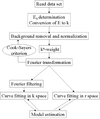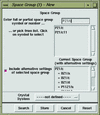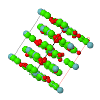issue contents
June 2002 issue
Crystallographic databases
Joint special issue with Acta Crystallographica Section D

Cover illustration: Images from crystallographic databases
research papers
The history and current use of the Crystallographic Information File (CIF) in databases and information handling applications are reviewed. CIF is an established standard data exchange mechanism in crystallography, but has the potential for interoperability with other data storage and transfer standards.
The ICDD is in the midst of an exciting transition to relational database formats for the Powder Diffraction File (PDF). The development of new PDF-4 products is aimed at enhancing our capability to perform materials design; fully digitized powder patterns are a first step in the realisation of this process.
The advantages of having the Powder Diffraction File (PDF) in the relational database format are discussed in terms of data-mining capabilities. The nature of the information recovered in these investigations is illustrated by several case studies.
The fourth version of the NIST Surface Structure Database (SSD-4) contains nearly 1300 structures. Methods for searching, structure comparison, and three-dimensional visualization and analysis are described.
CRYSTMET, a database of crystallographic data and computed powder patterns for metals, alloys and intermetallics, has been incorporated in a PC-based search program which provides a user-friendly query interface and a range of tools for visualizing and analysing the search results.
The integration of crystal structure databases, such as CRYSTMET, ICSD etc., with powerful quantum software permits the seamless computation of a variety of physical properties from crystal structure data.
X-ray absorption spectroscopy (XAS) is often used to study metals, and model building is an important part of XAS structural analyses. Use of a database of alloys and intermetallic crystal structures, such as CRYSTMET, is therefore a valuable adjunct to XAS analyses.
Recent developments in the Inorganic Crystal Structure Database (ICSD) are described, including the transition to a relational database structure and a new Windows-based graphical user interface. The importance of the ICSD in materials design is highlighted.
Download citation


Download citation


Information in the Inorganic Crystal Structure Database is used to locate suitable models for use in solving the structures of five novel compounds from powder diffraction data. Further quantum calculations were used to locate H atoms and to understand the hydrogen-bonding systems in these structures.
The creation, maintenance, information content and availability of the Cambridge Structural Database are summarized. Statistics show that the CSD will contain at least half a million crystal structures by the year 2010.
The development of two new programs, ConQuest for searching the CSD and Mercury for visualizing database entries, is described. The main features of both programs are illustrated. Particular emphasis has been placed on making these programs as intuitive as possible to a wide range of users.
Research applications of crystallographic information relating to organometallics and metal complexes stored in the Cambridge Structural Database are reviewed. The review concentrates on research work published in the past decade.
The CCDC's database of references to research applications of the CSD, DBUse, is described. It has been used to review a wide variety of research areas in organic chemistry and organic crystal chemistry, concentrating particularly on work reported since 1990.


 journal menu
journal menu





























